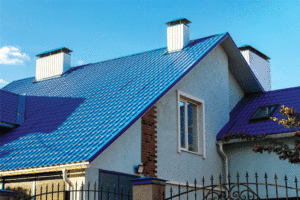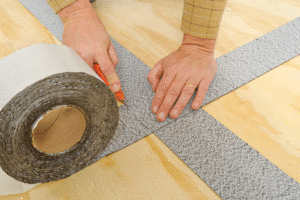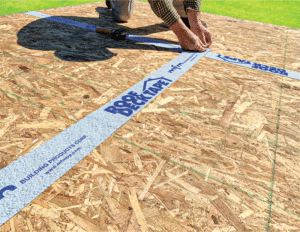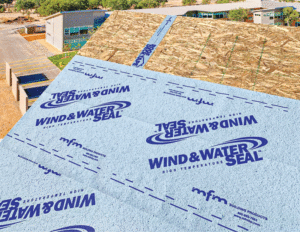Sealing the Seams
by Stacy Rinella | June 20, 2024 10:32 am
 [1]
[1]One of the most overlooked items in terms of waterproofing the roof deck is sealing the seams on the substrate boards of steep-slope roofing projects. This has caught the eye of several building code agencies who have already implemented codes to seal these seams with a roof deck flashing tape.
Some general contractors, both residential and commercial, have included sealing the roof deck seams as a general practice on their projects, regardless of whether it is code or not in their locale. Insurance companies are also taking notice of this practice as a good building strategy when it comes to protecting the building structure.
Changes in state and local building codes have already been implemented and more are sure to follow. The following is an overview of how to properly seal these seams for additional waterproofing protection.
 [2]
[2]entering the building structure.
The basics
The roof deck is the structural substrate to which the final roofing system will be applied. Typically, these are wood-oriented materials such as plywood or oriented strand board (OSB). When installed, the seams between all these boards are potential leak points for water, moisture, and air to infiltrate the building structure.
Typically, if water enters these seams during construction, it does not pose any real problems. However, when the roof is completed and interior work begins, this is when a roof deck tape provides the highest value to the contractor and customer.
 [3]
[3](4 in.) wide widths which should always be centered on the roof deck seam to ensure proper contact on each side of the deck seam.
Photos courtesy MFM Products
Membrane types
For the locales that have adopted this code, the general rule is the use of a 102 mm (4 in.) wide, 40-mm, self-adhering waterproofing membrane that meets ASTM D 1970, Standard Specification for Self-Adhering Polymer Modified Bituminous Sheet Materials Used as Steep Roofing Underlayment for Ice Dam Protection. In some cases, membranes which meet Architectural Manufacturers Association (AAMA) 711 are also accepted. Contractors need to investigate their building code specifics or, if not code in their locale, seek a suitable flashing membrane that meets ASTM D 1970 at a minimum.
In essence, the code wants the membrane to be self-adhering and self-sealing around common roofing fasteners when the final roof system is installed. The self-sealing aspect is critical in terms of maintaining complete waterproofing protection before, during, and after the roofing system has been installed.
 [4]
[4]
Metal roofing systems
For metal roofing systems specifically, a high-temperature rated deck flashing tape is preferrable due to the extreme heat generated beneath the panels. Most roofing contractors will opt for a product that is rated at a minimum of 107 C (225 F) for metal, steel, and aluminum systems. For installation under copper or zinc roofing, contractors should contact the manufacturer due to the higher heat levels generated from these materials.
Most codes will also address what types of underlayments can be used after sealing the deck seams. These include saturated felt, synthetic or self-adhering products. Although more economical, felts and synthetic underlayments offer limited waterproofing protection as compared to self-adhering underlayments. What is interesting to note is, even when using a self-adhering underlayment, the codes still require the use of a flashing tape on the deck panel seams.
The same rules apply for the underlayment in terms of heat rating. The flashing tape and the underlayment must be high temperature rated to prevent the mastic from melting and seeping out. When in doubt, contractors should always contact the manufacturer when using products under metal roofing systems.
Best practices
As with most roofing projects, contractors should start at the eave and work towards the ridge. The same is true when sealing the seams on roof deck panels. Tools required for installation include a sharp utility knife, measuring tape, hand roller, and any necessary safety equipment when working on a pitched roof.
Before using any self-adhering product, contractors should read and understand the manufacturer’s complete installation instructions. Most brands indicate a minimum installation temperature and maximum UV-exposure time. Depending on the manufacturer, some surfaces may require priming or there may be warnings about the types of caulks or sealants used in conjunction with the self-adhered membrane.
In general, when working with self-adhering products, it is recommended to roll the entire membrane thoroughly with a hand roller. This ensures maximum contact of the adhesive system to the substrate. Contractors should always pay special attention to any overlaps when rolling the membrane. On long runs, they may need to overlap the membrane to finish a section. On these end laps, the material should overlap by at least 102 to 152 mm (4 to 6 in.) and roll firmly.
As with most roofing products, always start at the eave and work upwards toward the roof peak. This allows the water to properly shed off the roof and not against the membrane. It is best to review the manufacturer’s installation instructions for proper
application steps.
Forward thinking
To some, it may seem like an unnecessary step to seal the roof deck seams. However, if it is a required code, contractors will want to follow the steps above to ensure the job is done right. If it is not required, it may be soon, or other builders may be adding this step as a selling feature to customers. All in all, it is just another step in the never-ending battle against Mother Nature.
David Delcoma is the operations manager for MFM Building Products Corp. Delcoma joined MFM in 2011 as the product marketing manager after serving more than 20 years with an industrial advertising agency. For more information, visit www.mfmbp.com/roof-deck-tape.
- [Image]: https://www.metalarchitecture.com/wp-content/uploads/2024/06/bigstock-Roof-Of-A-House-Or-Cottage-Mad-379800799.gif
- [Image]: https://www.metalarchitecture.com/wp-content/uploads/2024/06/MFM-Roof-Deck-Tape-03.gif
- [Image]: https://www.metalarchitecture.com/wp-content/uploads/2024/06/MFM-Roof-Deck-Tape-04.gif
- [Image]: https://www.metalarchitecture.com/wp-content/uploads/2024/06/MFM-Roof-Deck-Tape-05.gif
Source URL: https://www.metalarchitecture.com/articles/sealing-the-seams/